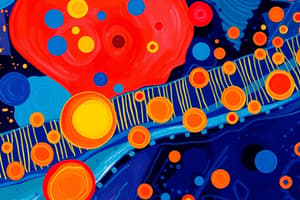Podcast
Questions and Answers
What are the two major components of all membranes?
What are the two major components of all membranes?
- Carbohydrates
- Lipids (correct)
- Proteins (correct)
- Nucleic acids
Carbohydrates have a significant role in the inner leaflets of membranes.
Carbohydrates have a significant role in the inner leaflets of membranes.
False (B)
Which of the following are types of glycerophospholipids?
Which of the following are types of glycerophospholipids?
- Phosphatidylserine (correct)
- Glycosphingolipids
- Sphingomyelin
- Phosphatidylcholine (correct)
What is the effect of unsaturated fatty acids on membrane fluidity?
What is the effect of unsaturated fatty acids on membrane fluidity?
Which lipids are abundant in nervous tissue?
Which lipids are abundant in nervous tissue?
What role does cholesterol play in membranes?
What role does cholesterol play in membranes?
The lipid bilayer is a rigid and static structure.
The lipid bilayer is a rigid and static structure.
The transition of a lipid molecule from one leaflets to the other is called ______.
The transition of a lipid molecule from one leaflets to the other is called ______.
Which abnormality affects membrane fluidity in spur cell anemia?
Which abnormality affects membrane fluidity in spur cell anemia?
Flashcards are hidden until you start studying
Study Notes
Chemical Composition of Plasma Membrane
- Plasma membranes consist primarily of lipids and proteins, with carbohydrates found mainly on outer leaflets.
- Carbohydrates associate with proteins (glycoproteins) or lipids (glycolipids) but play a minimal role in inner leaflets.
Major Components of Eukaryotic Membrane
- Glycerophospholipids, sphingolipids, and cholesterol are the three critical lipid types in eukaryotic membranes.
Glycerophospholipids
- Comprise glycerol with phosphate esterified at the α-carbon and two long-chain fatty acids attached.
- The type of alcohol attached to phosphatidic acid defines the specific glycerophospholipid (e.g., choline in phosphatidylcholine, serine in phosphatidylserine).
- Typically, one fatty acid is saturated (C1) and the other is unsaturated (C2), influencing membrane fluidity.
Ether Phospholipids
- Contain an alkyl group and include plasmalogens abundant in nervous tissue and the heart.
- High levels of ether-linked lipids correlate with metastatic cancer cells, suggesting a role in invasiveness.
Sphingolipids
- Built from amino alcohols sphingosine or dihydrosphingosine; ceramide forms the foundation with an acyl group linked to sphingosine.
- Sphingomyelins are prevalent in mammalian tissues, featuring phosphorylcholine at C1.
- Glycosphingolipids contain sugars linked to ceramide and include cerebrosides (either glucose or galactose variants).
Cholesterol
- Serves as a significant lipid component, being compact and hydrophobic with a polar hydroxyl group at C3.
- Cholesterol is crucial for maintaining membrane integrity, fluidity, and the formation of liquid-ordered rafts.
Role of Cholesterol in Membranes
- Integral to eukaryotic plasma membrane structure and function.
- Maintains membrane integrity and plays a role in raft/caveolae formation by spacing hydrocarbon chains of sphingolipids.
- Alterations in cholesterol levels can disrupt rafts, impacting membrane functionality.
Mobility of Lipid Components
- Lipid bilayers are dynamic; lipid molecules can rotate and diffuse laterally.
- All phospholipids in the plasma membrane are mobile rather than static, allowing for transverse diffusion between leaflets.
Abnormalities of Cell Membrane Fluidity
- Cholesterol is a key factor in maintaining membrane fluidity in mammals.
- Conditions like spur cell anemia illustrate how membrane fluidity abnormalities can affect cellular health.
Studying That Suits You
Use AI to generate personalized quizzes and flashcards to suit your learning preferences.




